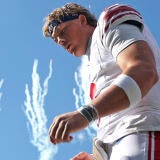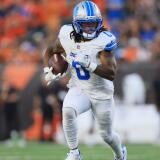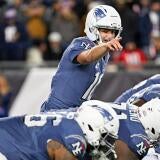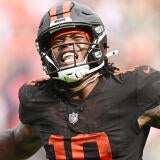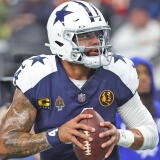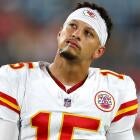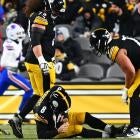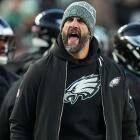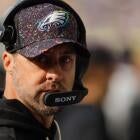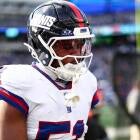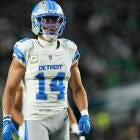Chiefs-Texans Key Matchup: Kansas City's pass rush vs. Houston's O-Line
The Chiefs have one of the most versatile and devastating rushes in the league. Houston's offensive line has been solid, but they'll be without their best pass protector this week. Can the Texans hold up?

As you no doubt already know, the Kansas City Chiefs started off this season 1-5, then won 10 games in a row to storm back from zero percent playoff odds and actually make the postseason as a wild card in the AFC.
You've heard about how they overcame the loss of running back Jamaal Charles -- how Alex Smith stopped turning the football over and started finding Jeremy Maclin on the perimeter, how the offense began putting more and more crooked numbers on the board. You've also heard about how much better the defense was over that period of time -- how Eric Berry, Sean Smith, and rookie Marcus Peters formed the backbone of an impressive secondary, how Derrick Johnson, Josh Mauga, and Dontari Poe held down the middle while Justin Houston, Tamba Hali, Dee Ford (while Houston was injured over the last five weeks of the season), Jaye Howard, Mike DeVito, and Allen Bailey handled the edges.
You may have even seen the numbers that show just how much the defense actually improved. In case you haven't, here they are again:
| Here Come the Chiefs | ||||||||
| WEEKS | W-L | OPP PPG | OPP YDS/GM | DEF DVOA | ||||
| 1-6 | 1-5 | 26.5 | 372.8 | 24th | ||||
| 7-17 | 10-0 | 12.8 | 303.2 | 2nd | ||||
The defining characteristic of the Chiefs' defense all year, even while they were slumping to their 1-5 start, has been pressure.
Kansas City got pressure (sacks, hits, and/or hurries) on 36.8 percent of opponent drop backs during the slow start, per Pro Football Focus, then upped that percentage to 40.4 percent while going 10-0 down the stretch of the season. (They pressured Houston's QBs on 32.6 percent of drop backs in Week 1, but both of these teams were significantly different way back then.) Even while Houston was on the sideline for the final five games, the Chiefs continued that increased pressure. They got to the quarterback on 39.2 percent of drop backs over those five weeks while Ford -- a second-year pro that wildly disappointed as a rookie and barely played this season before Houston went down -- filled in for one of the top pass rushers in the NFL.

Predictably, quarterbacks did not fare very well when under pressure from Kansas City's defenders this season. Pretty much every quarterback in the league is worse when faced with defenders in his face, and the passers that went up against the Chiefs' rush were no exception. Opposing passers completed only 46.6 percent of their passes for 5.7 yards per attempt and registered a passer rating of just 66.0 on plays where the Chiefs got to the quarterback, per PFF.
It's fitting, then, that this week's opponent is the Houston Texans. While Houston's Adjusted Sack Rate (Football Outsiders' statistic that adjusts sacks plus intentional grounding penalties for down, distance, and opponent) is slightly above average, Pro Football Focus that the Texans allowed pressure on the eighth lowest percentage of their passing plays. When Brian Hoyer -- this week's starter, now that he's back from his concussion -- was the one under center, that percentage dropped further. He was pressured less often than all but three quarterbacks this season, per PFF's tracking.
When Hoyer was under pressure, though, he was affected more than almost any other QB in the league.
| Brian Hoyer Under Pressure | |||||
| PRESSURE? | COMP % | YPA | TD | INT | RTG |
| No | 66.2% | 7.6 | 15 | 4 | 100.7 |
| Yes | 44.0% | 5.6 | 4 | 3 | 63.1 |
He was significantly more effective this season when able to get the ball out quickly and on rhythm than when he had to hang onto it a bit longer, whether due to good coverage or the rush knocking him off his spot in the pocket. On throws within 2.5 seconds of the snap, Hoyer completed 66.2 percent of the time. After 2.6 seconds, Hoyer's completion rate dropped to 52.1 percent.
Hoyer's blind side protector, Duane Brown, was placed on injured reserve earlier this week after tearing a tendon in his quad during the team's Week 17 win over the Jaguars. Brown graded out as one of PFF's top-10 pass-blocking left tackles this season. Without him, Houston will have to turn to his backup, Chris Clark, to keep Hali (and Ford) at bay. That's an incredibly tall task, so they'll likely have to give him some help in the form of backs and receivers executing double-teams or chip blocks.
That leaves fewer blockers to handle guys like Houston, Poe, Howard, DeVito, and Bailey, which often spells doom for opposing offenses. If the Texans want to advance, though, it may just be the key to the game.


